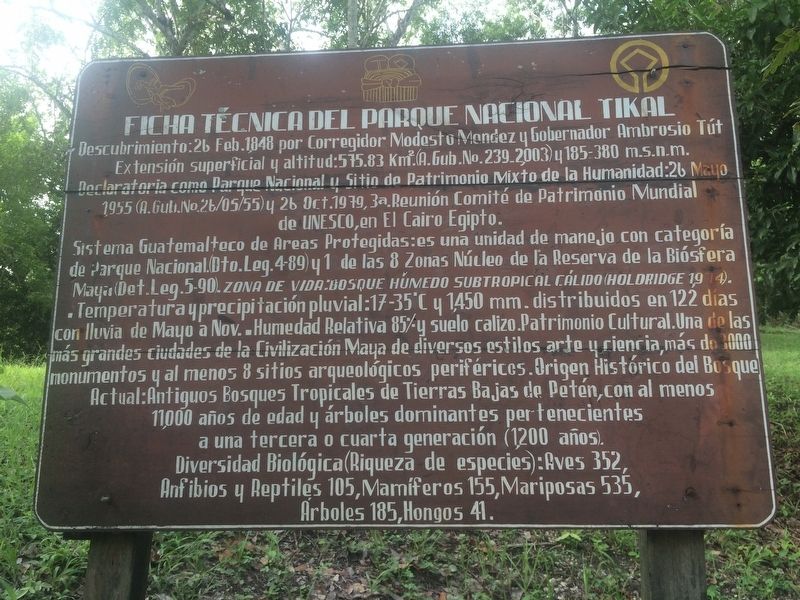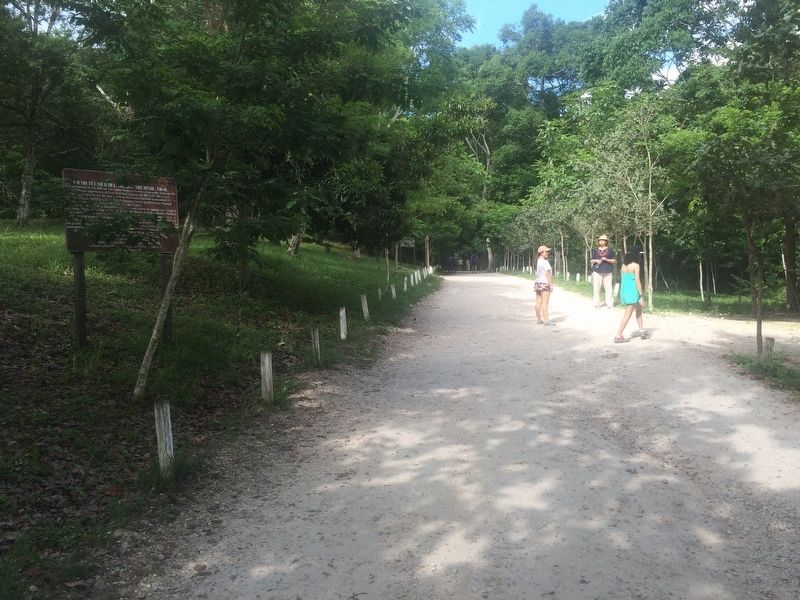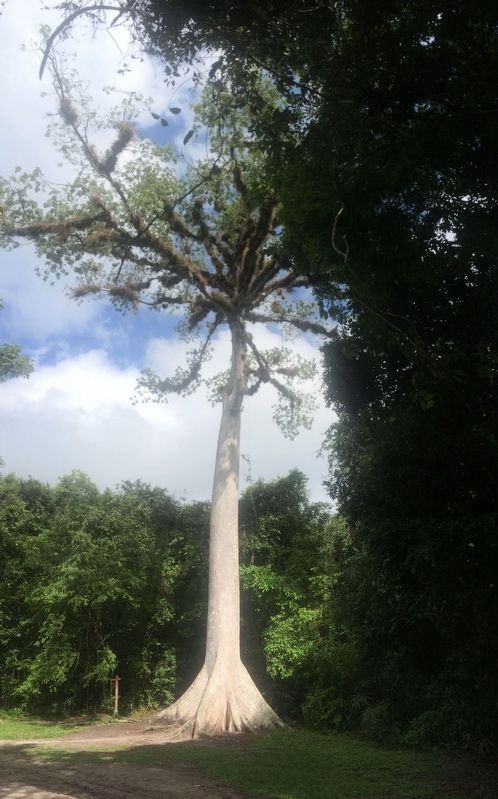Flores, Petén, Guatemala — Central America
Tikal Archaeological Park
Descubrimiento: 26 Feb. 1,848 por Corregidor Modesto Mendez y Gobernador Ambrosio Tút
Extensión superficial y altitud: 575.83 Km.2 (A. Gub. No. 239.2003) y 185-380 m.s.n.m.
Declaratoria como Parque Nacional y Sitio Patrimonio Mixto de la Humanidad: 26 Mayo 1,955 (A. Gub. No. 26/05/55) y Oct. 1979, 3ª. Reunión Comité de Patrimonio Mundial de UNESCO, en el Cairo Egipto.
Sistema Guatemalteco de Áreas Protegidas: es una unidad de manejo con categoría de Parque Nacional (Dto. Leg. 4-89) y 1 de las 8 Zonas Núcleo de la Reserva de la Biósfera Maya (Det. Leg. 5-90). Zona de vida: bosque húmedo subtropical cálido (Holdridge 1,974).
· Temperatura y precipitación pluvial: 17-35⁰C y 1,450 mm. Distribuidos en 122 días con lluvia de Mayo a Nov. Humedad Relativa 85% y suelo calizo. Patrimonio Cultural. Una de las más grandes ciudades de la Civilización Maya de diversos estilos arte y ciencia, más de 3000 monumentos y al menos 8 sitios arqueológicos periféricos. Origen Histórico del Bosque Actual: Antiguos Bosques Tropicales de Tierras Bajas de Petén, con al menos 11,000 años de edad y árboles dominantes pertenecientes a una tercera o cuarta generación (1,200 años).
Diversidad Biológico (Riqueza de especies): Aves 352, Anfibios y Reptiles 105, Mamíferos 155, Mariposas 535, Árboles 185, Hongos 41.
The modern discovery of Tikal took place on February 26, 1848 by Chief Magistrate Modesto Méndez and Governor Ambrosio Tút.
The park has a surface area of 575.83 km2 (according to the Governmental Accord No. 239.2003) and an elevation of 185-380 meters above sea level.
Its declaration as a National Park and mixed-use Global Heritage Site was made on May 26, 1955 (Governmental Accord No. 26.05.55.) and at the October 3, 1979 World Heritage Committee Meeting of the UNESCO in Cairo, Egypt.
The Tikal Park is a management unit in the Guatemalan System of Protected Areas with National Park status (Legal Decree 4-89) and one of the eight Central Zones of the Maya Biosphere Reserve (Legal Decree 5-90). The type of habitat is humid, warm subtropical forest (Holdridge, 1974).
· Temperature and rainfall: 17-35⁰C and 1450 mm annually distributed over an average of 122 days of rain from May to November. Relative humidity is normally 85% and the soil is chalky. In terms of cultural heritage it is one of the largest cities of Maya civilization, with different styles of art and science. There are more than 3,000 monuments at the site, with at least eight peripheral archaeological sites. The historical origin of the forest goes back as far as 11,000 years for this old lowland rainforest, with dominant trees belonging to a third or fourth generation (going back 1200 years or more). Its rich biological diversity includes the following numbers of species: 352 birds, 105 reptiles and amphibians, 155 mammals, 535 butterflies, 185 trees and 41 mushrooms.
Topics and series. This historical marker is listed in these topic lists: Anthropology & Archaeology • Environment. In addition, it is included in the UNESCO World Heritage Sites series list. A significant historical date for this entry is February 26, 1848.
Location. 17° 13.491′ N, 89° 36.802′ W. Marker is in Flores, Petén. Marker is on Carretera 3, on the left when traveling west. The marker is to the left of the walking trail a few meters after entering the Tikal National Park. This short portion of the trail is also part of Carretera 3 (Road No. 3) that eventually leads north to the town and archaeological site of Uaxactún. Touch for map. Marker is in this post office area: Flores, Petén 17001, Guatemala. Touch for directions.
Other nearby markers. At least 8 other markers are within 2 kilometers of this marker, measured as the crow flies. The "Acanaladuras" Palace (approx. 0.9 kilometers away); East Plaza at Tikal
(approx. one kilometer away); Temple II (approx. 1.2 kilometers away); Temple V at Tikal (approx. 1.2 kilometers away); Temple III at Tikal National Park (approx. 1.4 kilometers away); The Bat Palace (approx. 1.6 kilometers away); Great Pyramid (approx. 1.6 kilometers away); Twin Pyramid Complex N (approx. 1.6 kilometers away). Touch for a list and map of all markers in Flores.
Credits. This page was last revised on March 2, 2018. It was originally submitted on October 21, 2016, by J. Makali Bruton of Accra, Ghana. This page has been viewed 260 times since then and 6 times this year. Photos: 1, 2, 3. submitted on October 21, 2016, by J. Makali Bruton of Accra, Ghana.


